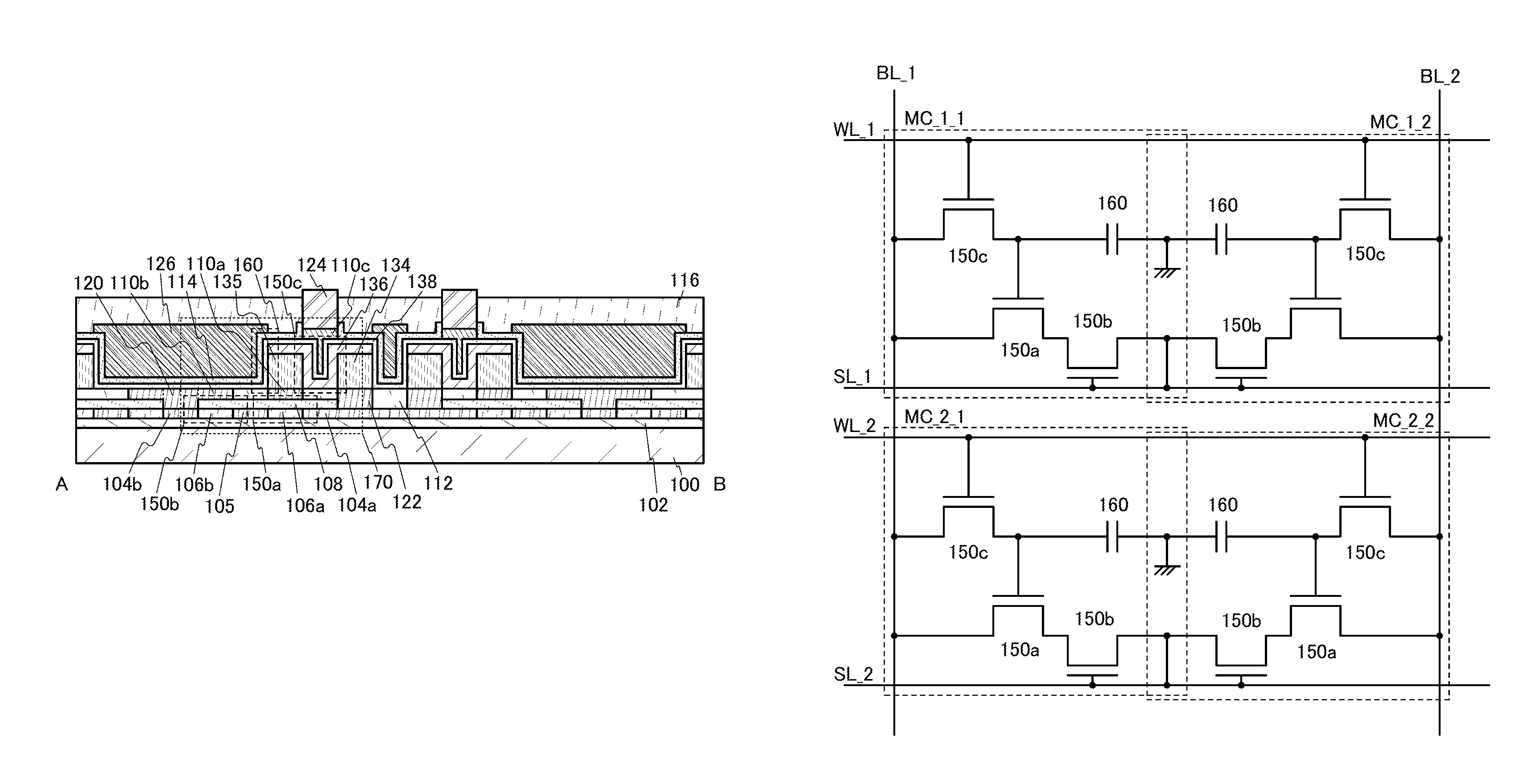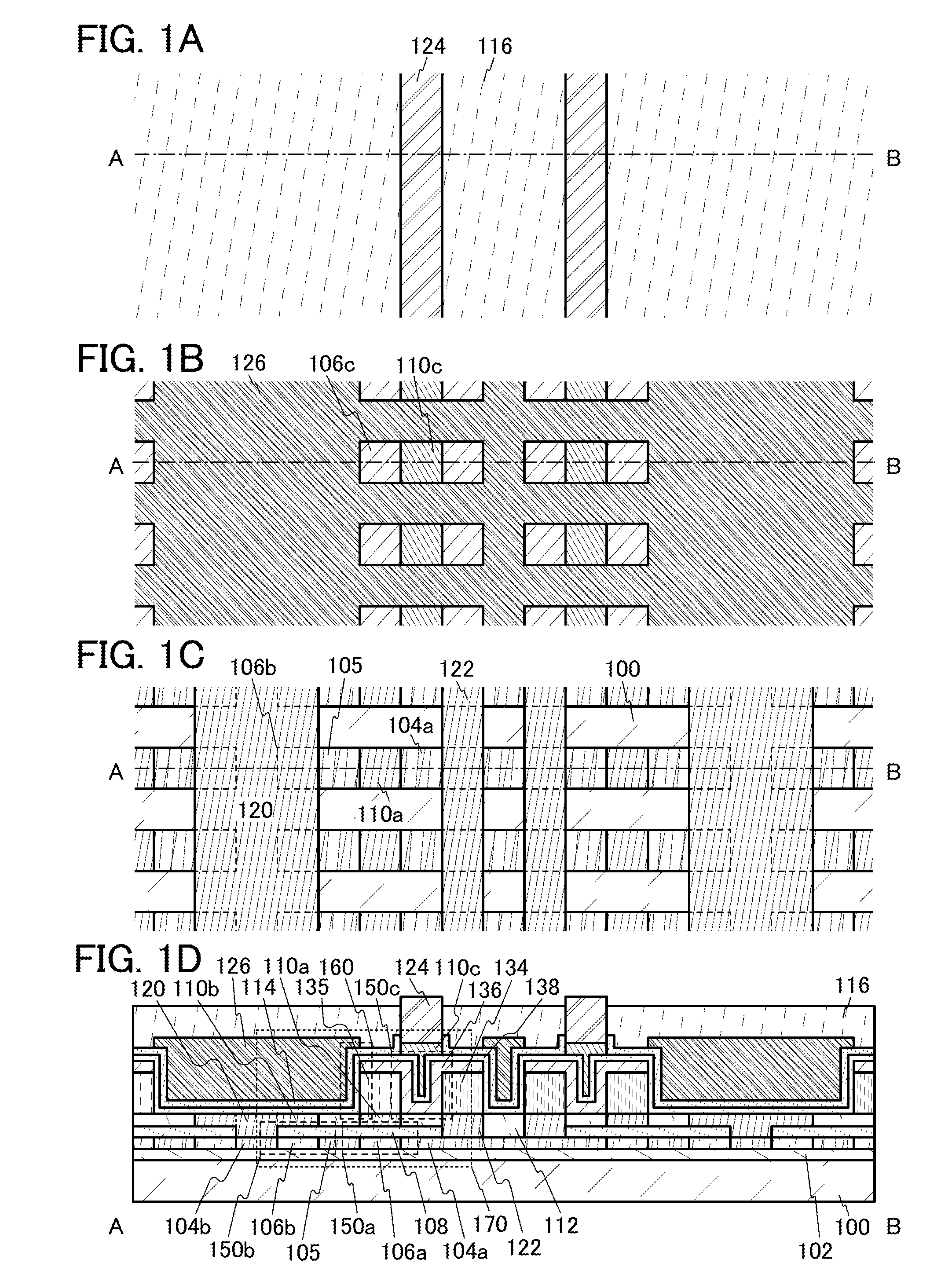Semiconductor memory device
a memory device and semiconductor technology, applied in the direction of transistors, solid-state devices, instruments, etc., can solve the problems of short data retention time, increased power consumption, and loss of charge, so as to reduce the off-state current of the transistor, reduce oxygen vacancy, and reduce impurities
- Summary
- Abstract
- Description
- Claims
- Application Information
AI Technical Summary
Benefits of technology
Problems solved by technology
Method used
Image
Examples
embodiment 1
(Embodiment 1)
[0048]In this embodiment, a semiconductor memory device to which one embodiment of the present invention is applied will be described.
[0049]FIGS. 1A to 1C are top views illustrating parts of layers at respective levels of a memory cell array that is a semiconductor memory device. FIG. 1D illustrates a cross-section A-B corresponding to a dashed-dotted line A-B in FIGS. 1A to 1C. Note that FIG. 1A illustrates a layer at a level closer to a top surface, and FIG. 1C illustrates a layer at a level closer to a substrate 100. FIG. 1B illustrates a layer between the layers of FIGS. 1A and 1C. For simplification, some films (e.g., a first insulating film 102, a second insulating film 108, a third insulating film 112, a fourth insulating film 138, a fifth insulating film 114, and the like) are not illustrated in the top views.
[0050]The cross section A-B illustrated in FIG. 1D is described.
[0051]The memory cell array illustrated in FIG. 1D includes a memory cell 170 and a memory...
embodiment 2
(Embodiment 2)
[0158]In this embodiment, a memory cell array including memory cells, which has a different structure from that described in Embodiment 1 will be described with reference to FIGS. 5A and 5B.
[0159]A memory cell 270 illustrated in FIG. 5A is different from the memory cell 170 in that a fourth insulating film 238 is provided only over an oxide semiconductor film 136. That is, the shape of a top surface of the fourth insulating film 238 substantially corresponds to the shape of a top surface of the oxide semiconductor film 136.
[0160]Since the fourth insulating film 238 is provided over only the oxide semiconductor film 136, a capacitor 260 has a different shape from the capacitor 160. Specifically, a netlike conductive film 226, the fourth insulating film 238, and a fifth insulating film 214 are provided without the netlike conductive film 126, the fourth insulating film 138, and the fifth insulating film 114.
[0161]Since the fourth insulating film 238 is provided over only...
embodiment 3
(Embodiment 3)
[0172]A central processing unit (CPU) can be formed using the semiconductor memory device described in Embodiment 1 or Embodiment 2 for at least part of the CPU.
[0173]FIG. 6A is a block diagram illustrating a specific structure of a CPU. The CPU illustrated in FIG. 6A includes an arithmetic logic unit (ALU) 1191, an ALU controller 1192, an instruction decoder 1193, an interrupt controller 1194, a timing controller 1195, a register 1196, a register controller 1197, a bus interface (Bus I / F) 1198, a rewritable ROM 1199, and an ROM interface (ROM I / F) 1189 over a substrate 1190. A semiconductor substrate, an SOI substrate, a glass substrate, or the like is used as the substrate 1190. The ROM 1199 and the ROM interface 1189 may be provided over a separate chip. Obviously, the CPU illustrated in FIG. 6A is only an example in which the structure is simplified, and a variety of structures is applied to an actual CPU depending on the application.
[0174]An instruction that is in...
PUM
 Login to View More
Login to View More Abstract
Description
Claims
Application Information
 Login to View More
Login to View More - R&D
- Intellectual Property
- Life Sciences
- Materials
- Tech Scout
- Unparalleled Data Quality
- Higher Quality Content
- 60% Fewer Hallucinations
Browse by: Latest US Patents, China's latest patents, Technical Efficacy Thesaurus, Application Domain, Technology Topic, Popular Technical Reports.
© 2025 PatSnap. All rights reserved.Legal|Privacy policy|Modern Slavery Act Transparency Statement|Sitemap|About US| Contact US: help@patsnap.com



